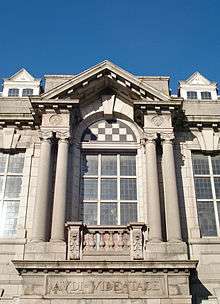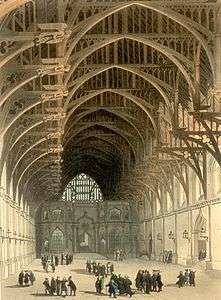Edwardian architecture
Edwardian architecture is a Neo-Baroque architectural style that was popular in the British Empire during the Edwardian era (1901–1910). Architecture up to the year 1914 may also be included in this style.[1]
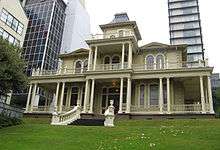
Description
Edwardian architecture is generally less ornate than high or late Victorian architecture,[2] apart from a subset – used for major buildings – known as Edwardian Baroque architecture.
The Victorian Society campaigns to preserve architecture built between 1837 and 1914, and so includes Edwardian as well as Victorian architecture within its remit.[3]
Characteristics
The characteristic features of the Edwardian Baroque style were drawn from two main sources: the architecture of France during the 18th century and that of Sir Christopher Wren in England during the 17th—part of the English Baroque (for this reason Edwardian Baroque is sometimes referred to as "Wrenaissance"). Sir Edwin Lutyens was a major exponent, designing many commercial buildings in what he termed 'the Grand Style' during the later 1910s and 1920s. This period of British architectural history is considered a particularly retrospective one, since it is contemporary with Art Nouveau.
Typical details of Edwardian Baroque architecture include extensive rustication, usually more extreme at ground level, often running into and exaggerating the voussoirs of arched openings (derived from French models); domed corner rooftop pavilions and a central taller tower-like element creating a lively rooftop silhouette; revived Italian Baroque elements such as exaggerated keystones, segmental arched pediments, columns with engaged blocks, attached block-like rustication to window surrounds; colonnades of (sometimes paired) columns in the Ionic order and domed towers modelled closely on Wren's for the Royal Naval College in Greenwich. Some Edwardian Baroque buildings include details from other sources, such as the Dutch gables of Norman Shaw's Piccadilly Hotel in London.
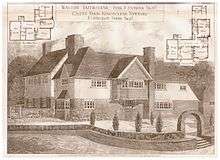
Other characteristics include:
- Colour: lighter colours were used; the use of gas and later electric lights caused designers to be less concerned about the need to disguise soot buildup on walls compared to Victorian era architecture.[2]
- Patterns: "Decorative patterns were less complex; both wallpaper and curtain designs were more plain."[2]
- Clutter: "There was less clutter than in the Victorian era. Ornaments were perhaps grouped rather than everywhere."
Architectural influences
- Victorian[2]
- Art Nouveau[2]
- Georgian[2]
- Arts and Crafts[2]
- Federation[4]
Notable examples
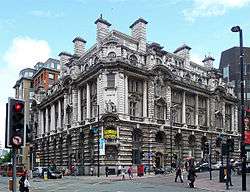
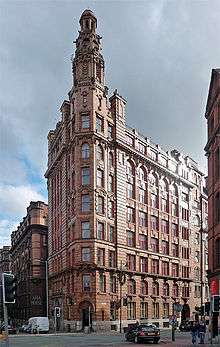
United Kingdom
- Admiralty Arch, London (1912)
- Albert Hall, Manchester (1910)
- Albert Hall, Nottingham (1910)
- Arding & Hobbs, London (1910)
- Ashton Memorial, Lancaster, by John Belcher (1909)
- Asia House, Manchester (1909)
- Australia House, London (1918)
- Belfast City Hall, Belfast, by Brumwell Thomas (1906)
- Blythe House, London, by Henry Tanner (architect) (1903)
- Bridgewater House, Manchester (1912)
- Cardiff City Hall, Cardiff, by Henry Vaughan Lanchester, Edwin Alfred Rickards & James A. Stewart, (1906)
- Cardiff Crown Court, Cardiff, by Henry Vaughan Lanchester, Edwin Alfred Rickards & James A. Stewart, (1906)
- Central Criminal Court (Old Bailey), London, by Edward William Mountford (1902–07)
- County Hall, London (1922)
- Electric Cinema, London (1910)
- Government Offices Great George Street, London, by John Brydon, (1908–17)
- Hanover Building, Manchester (1909)
- Hove Library, Hove (1907–08)[5]
- India House, Manchester (1906)
- Laing Art Gallery, Newcastle upon Tyne (1904)
- Lancaster House, Manchester (1910)
- London Road Fire and Police Station, Manchester (1906)
- Lloyds Bank on King Street, Manchester by Charles Heathcote (1915)
- Manchester Victoria station, Manchester (1909)
- Marylebone station, London. (1899)
- Midland Bank head office building, London by Edwin Lutyens (1922)
- Mitchell Library, Glasgow, William B Whitie (1906–11)
- Municipal Technical Institute, a.k.a. Blackman Tech, Belfast (1906)[6]
- Nottingham railway station, Nottingham (1904)
- 163 North Street, Brighton (1904)[7]
- Port of Liverpool Building, Liverpool, by Sir Arnold Thornely, F.B. Hobbs, Briggs and Wolstenholme (1903–07)
- Ralli Hall, Hove (1913)[8]
- St. James Buildings, Manchester (1912)
- South Shields Town Hall, South Shields (1905–10)
- Stockport Town Hall, Stockport, by Brumwell Thomas (1908)
- War Office, London (1906)
- Westminster Central Hall, by Henry Vaughan Lanchester, Edwin Alfred Rickards & James A. Stewart, London (1911)
Argentina
- Thompson Muebles Ltd, Buenos Aires (1914)
- Harrods - Bs.As. Ltd, Buenos Aires (1914)
- Retiro Mitre railway station, Buenos Aires (1915)
Australia
- Lands Administration Building, Brisbane
- Queen Victoria Hospital, Melbourne (main pavilion, now Queen Victoria Women's Centre)
- Commonwealth Offices, Treasury Place, Melbourne
- Central Railway Station, Sydney
- Department of Education building, Sydney (1912)[9]
- General Post Office, Hobart
Canada
- Post Office (now part of Sinclair Centre), Vancouver
Hong Kong
- Main Building of The University of Hong Kong
- Ohel Leah Synagogue
- Old Dairy Farm Depot
- Western Market
India
- Ripon Building, Chennai
- Chowringhee Mansions, Calcutta
- Rashtrapati Bhavan, New Delhi
Malaysia
- City Hall, George Town, Penang (1903)
- Second floor extension to Town Hall, George Town, Penang (1903)
- Former Government Offices (now State Islamic Council building), George Town, Penang (1907)
- Federated Malay States railway station/Malayan Railways building (Wisma Kastam), George Town, Penang by Arthur Benison Hubback (1907)
- George Town Dispensary/Wisma Yeap Chor Ee, George Town, Penang (1922)
- Ipoh Town Hall and former General Post Office, Ipoh, Perak (1916)
- Railway station in Ipoh, Perak by Arthur Benison Hubback (1917 to 1935)
- Former State Secretariat (State Library), Seremban, Negeri Sembilan (1912)
New Zealand
- Auckland Town Hall, Auckland, New Zealand
- General Post Office (former), Auckland, New Zealand
- Auckland Ferry Terminal
- Old Public Trust Building, Wellington (1909)
Singapore
- Victoria Memorial Hall (1905)
- Central Fire Station (1908)
- Saint Joseph's Institution (1900s, 1910s extensions)
Sri Lanka
See also
References
- Long, Helen C. (1993), The Edwardian House: The Middle-class Home in Britain, 1880-1914, Manchester: Manchester University Press
- "Bricks & Brass: Edwardian Style". Bricksandbrass.co.uk. Retrieved 2016-10-25.
- "What we do". The Victorian Society. Retrieved 2016-10-25.
- Evans, Ian (1999) [1986]. The Federation House. Mullumbimby, NSW: Flannel Flower Press. p. 8. ISBN 1-875253-11-4.
- Antram, Nicholas; Pevsner, Nikolaus (2013). Sussex: East with Brighton and Hove. The Buildings of England. London: Yale University Press. p. 247. ISBN 978-0-300-18473-0.
- http://www.belfastmet.ac.uk/about-us/history-of-the-college/
- Antram, Nicholas; Morrice, Richard (2008). Brighton and Hove. Pevsner Architectural Guides. London: Yale University Press. p. 165. ISBN 978-0-300-12661-7.
- Historic England. "Ralli Memorial Hall, walls and railings, Denmark Villas, Hove (Grade II) (1298671)". National Heritage List for England. Retrieved 6 March 2013.
- "Department of Education Building". NSW State Heritage Register. Office of Environment & Heritage, Government of New South Wales. 9 February 2015. Retrieved 30 December 2016.
Further reading
- Gray, A. S., Edwardian Architecture: a Biographical Dictionary (1985).
- Long, H., The Edwardian House: the Middle-Class Home in Britain 1880-1914 (1993).
- Hockman, H.,
- Service, A., Edwardian Architecture: Edwardian House Style Handbook (2007) David & Charles ISBN 0-7153-2780-1 (1977) Thames & Hudson ISBN 0-500-18158-6
